Verdun
Verdun | |
|---|---|
Subprefecture and commune | |
Verdun and the Meuse river | |
 Coat of arms | |
Location of Verdun 
| |
 Verdun 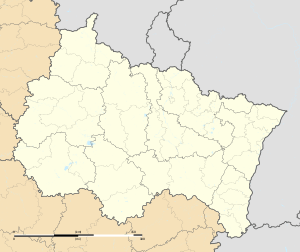 Verdun | |
| Coordinates: 49°09′43″N 5°23′15″E | |
| Country | France |
| Region | Grand Est |
| Department | Meuse |
| Arrondissement | Verdun |
| Canton | Verdun-1 and 2 |
| Government | |
| • Mayor | Samuel Hazard |
| Area 1 | 31.03 km2 (11.98 sq mi) |
| Population (2017-01-01)[1] | 17,475 |
| • Density | 560/km2 (1,500/sq mi) |
| Time zone | UTC+01:00 (CET) |
| • Summer (DST) | UTC+02:00 (CEST) |
| INSEE/Postal code | 55545 /55100 |
| Elevation | 194–330 m (636–1,083 ft) |
| 1 French Land Register data, which excludes lakes, ponds, glaciers > 1 km2 (0.386 sq mi or 247 acres) and river estuaries. | |
Imperial City of Verdun | |||||||
|---|---|---|---|---|---|---|---|
| ? – 1648 | |||||||
 Coat of arms
| |||||||
| Status | Free Imperial City of the Holy Roman Empire | ||||||
| Capital | Verdun | ||||||
| Government | Republic | ||||||
| Historical era | Middle Ages | ||||||
• Established | Uncertain | ||||||
| 1648 | |||||||
| 1648 | |||||||
| |||||||
| Today part of | |||||||
Verdun (UK: /vɜːrˈdʌn, ˈvɛərdʌn/,[2][3] US: /vərˈdʌn, vɛərˈdʌn/;[3][4][5] French: [vɛʁdœ̃]; official name before 1970 Verdun-sur-Meuse) is a small city in the Meuse department in Grand Est in northeastern France. It is an arrondissement of the department.
Verdun is the biggest city in Meuse, although the capital of the department is Bar-le-Duc which is slightly smaller than Verdun. It is well known for giving its name to a major battle of the First World War.
History
Verdun (Verodunum, a latinisation of a place name meaning "strong fort") was founded by the Gauls.It has been the seat of the bishop of Verdun since the 4th century, with interruptions.[6] In 486, following the decisive Frankish victory at the Battle of Soissons, the city (amongst several other nearby cities) refused to yield to the Franks and was thus besieged by King Clovis I.[7] The 843 Treaty of Verdun divided Charlemagne's empire into three parts.
At around this time Verdun was the centre of a Europe-wide thriving trade selling young boys to be enslaved eunuchs to the Islamic emirates of Iberia.[8]
Verdun is also famous for its Dragées or sugared almonds from 1200 onward; they were distributed at the baptism of French princes.[9]
Verdun was part of the middle kingdom of Lotharingia, and in 1374 it became a free imperial city of the Holy Roman Empire. The Bishopric of Verdun formed together with Tull (Toul) and Metz the Three Bishoprics, which were annexed by France in 1552 (recognized in 1648 by the Peace of Westphalia).
From 1624 to 1636, a large bastioned citadel was constructed on the site of the Abbey of Saint Vanne. In 1670, Sébastien Le Prestre de Vauban visited Verdun and drew up an ambitious scheme to fortify the whole city. Although much of his plan was built in the following decades, some of the elements were not completed until after the Napoleonic Wars. Despite the extensive fortifications, Verdun was captured by the Prussians in 1792 during the War of the First Coalition, but abandoned by them after the Battle of Valmy. During the Napoleonic War, the citadel was used to hold British prisoners of war.
In the Franco-Prussian War, Verdun was the last French fortress to surrender in 1870. Shortly afterwards, a new system of fortification was begun.[10] This consisted of a mutually supporting ring of 22 polygonal forts up to 8 kilometres (5.0 mi) from the city, and an inner ring of 6 forts.[11]
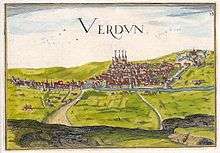
Battle of Verdun (1792)
The Battle of Verdun was fought on August 20, 1792 between French Revolutionary forces and a Prussian army. The Prussians were victorious. This therefore opened the path to Paris.[12]
Battle of Verdun (First World War)
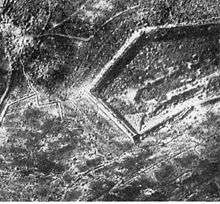
Verdun was the site of a major battle, the longest-lasting of the First World War.[13] One of the costliest battles in military history, Verdun exemplified the policy of a "war of attrition" pursued by both sides, which led to an enormous loss of life and very large casualty lists.[14]
Following the failure of the Schlieffen Plan in 1914 and the solidifying of the Western Front,[15] Germany remained on the strategic defensive in the west throughout most of 1915.[16] In the winter of 1915–16, German General Erich von Falkenhayn, the chief of the German General Staff (1914–1916) made plans for a large offensive on the Western Front that ultimately aimed to break the French Army through the application of firepower at a point that the French had to hold for reasons of national prestige.[17] As Falkenhayn recalled it, his so-called "Christmas memorandum" to Kaiser Willhelm II envisioned a massive but limited attack on a French position 'for the retention of which the French Command would be compelled to throw in every man they have'.[18] Once the French army had bled to death, Britain could be brought down by Germany's submarine blockade and superior military strength. The logic of initiating a battle not to gain territory or a strategic position but simply to create a self-sustaining killing ground—to bleed the French army to death—pointed to the grimness of military vision in 1916.
Recent scholarship by Holger Afflerbach and others, however, has questioned the veracity of the Christmas memo. No copy has ever surfaced and the only account of it appeared in Falkenhayn's post-war memoir.[19] His army commanders at Verdun, including the German Crown Prince, denied any knowledge of an attrition strategy. It is possible that Falkenhayn did not specifically design the battle to bleed the French army but used this supposed motive after the fact in an attempt to justify the Verdun offensive, despite its failure.
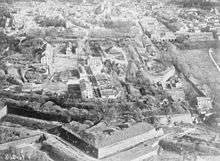
Verdun was the strongest point in pre-war France, ringed by a string of powerful forts, including Douaumont and Fort Vaux. By 1916, the salient at Verdun jutted into the German lines and lay vulnerable to attack from three sides. The historic city of Verdun had been an oppidum of the Gauls before Roman times and later a key asset in wars against Prussia, and Falkenhayn suspected that the French would throw as many men as necessary into its defence. Ironically, France had substantially weakened Verdun's defences after the outbreak of the war, an oversight that would contribute to the removal of Joseph Joffre from supreme command at the end of 1916. The attack was slated to begin on 12 February, then 16 February, but the snow forced repeated postponements.
_(14578428098).jpg)
Falkenhayn massed artillery to the north and east of Verdun to precede the infantry advance with intensive artillery bombardment. His attack would hit the French positions on the right bank of the Meuse. Although French intelligence had warned of his plans, these warnings were ignored by the French Command and troop levels in the area remained low. Consequently, Verdun was utterly unprepared for the initial bombardment on the morning of 21 February 1916. German infantry attacks followed that afternoon and met tenacious but ultimately inadequate resistance for the first four days.
On 25 February, the Germans occupied Douaumont. French reinforcements—now under the leadership of General Philippe Pétain—began to arrive and were instantly thrown into "the furnace" (as the battle was called) to slow the German advance, no matter what the cost. Over the next several days, the stubborn defense managed to slow the German advance with a series of bloody counter-attacks. In March, Falkenhayn decided to target the French positions on the left bank of the Meuse as well, broadening the offensive front twofold. Throughout March and April, Cumières-le-Mort-Homme and Hill 304 were under continuous heavy bombardment and relentless infantry attacks. Meanwhile, Pétain organised repeated, small-scale counter-attacks to slow the German advance. He also ensured that the sole supply road from Bar-le-Duc into Verdun remained open. It became known as the Voie Sacrée "Sacred Way" because it continued to carry vital supplies and reinforcements into the Verdun front despite constant artillery fire.
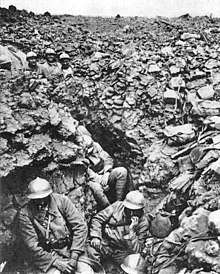
German gains continued in June, but slowly and only after increasingly heavy losses on their side. On 7 June, following almost a week of bitter resistance, Fort Vaux fell to the Germans after a murderous hand-to-hand fight inside the fort itself. On 23 June, the Germans reached what would become the furthest point of their advance. The line was just in front of Fort Souville, the last stronghold before Verdun itself. Pétain was making plans to evacuate the right bank of the Meuse when the combined Anglo-French offensive on the Somme River was launched on 1 July, partly to relieve pressure on the French, although the first day was the bloodiest in the British Army's history. The Germans could no longer afford to continue their offensive at Verdun when they were needed so desperately on the Somme. At a cost of some 400,000 German casualties and a similar number of French, the attack was finally called off. Germany's intention to bleed France to death had failed.
The battle continued, however, from October to the end of the year. French offensives, employing new tactics devised by General Robert Nivelle, regained the forts and territory they had lost earlier. This was the only gleam of hope in an otherwise abysmal landscape.
Overall, the battle lasted 11 months. Falkenhayn was replaced by Paul von Hindenburg as Chief of General Staff. General Nivelle was promoted over the head of General Pétain to replace Generalissimo Joseph Joffre as French supreme commander, although he was to hold the post for less than six months.
Panoramic views
Cemetery and memorials
There are many French and German cemeteries throughout the battlefield. The largest is the French National Cemetery and Douaumont Ossuary near Fort Douaumont. Thirteen thousand crosses adorn the field in front of the ossuary, which holds roughly 130,000 unidentified remains brought in from the battlefield. Every year yields more remains, which are often placed inside the ossuary's vaults.
Among many revered memorials on the battlefield is the "Bayonet Trench", which marks the location where some dozen bayonets lined up in a row were discovered projecting out of the ground after the war; below each rifle was the body of a French soldier. It has been assumed that these belonged to a group of soldiers who had rested their rifles against the parapet of the trench they were occupying when they were killed during a bombardment, and the men were buried where they lay in the trench and the rifles left untouched. However, this is probably not historically accurate: experts agree that the bayonets were probably affixed to the rifles after the attack, and installed by survivors to memorialize the spot.[20]
Nearby, the World War I Meuse-Argonne American Cemetery and Memorial is located at Romagne-sous-Montfaucon to the northwest of Verdun. It is the final resting place for 14,246 American military dead, most of whom died in the Meuse-Argonne Offensive. The chapel contains a memorial to the 954 American missing whose remains were never recovered or identified.
On 12 September 1916 King George V awarded the Military Cross to the City of Verdun, one of only two awards of this British decoration to a municipality during World War I, the other being Ypres.[21] On 5 October 1917, Bernardino Machado, President of the Portuguese Republic, awarded the City of Verdun the Order of the Tower and Sword, 1st Class (Grand Cross) for its "tenacious resistance, steadfastness in battle, and heroism of its garrison, having filled a brilliant position in the present war and gloriously proving the worth of a nation's valour and patriotism"; the investiture ceremony took place on 10 October 1917, during President Machado's visit to the Western Front.[22]
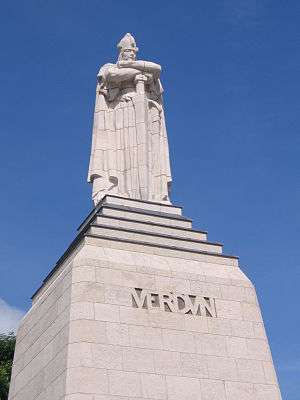 Charlemagne at the summit of Verdun's Victory Monument
Charlemagne at the summit of Verdun's Victory Monument A portion of the battlefield today
A portion of the battlefield today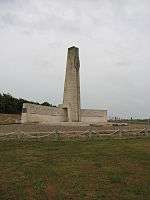 The Voie Sacrée memorial at Nixéville-Blercourt near Verdun, commemorating the French army's intensive use of the Bar-le-Duc to Verdun road during the battle
The Voie Sacrée memorial at Nixéville-Blercourt near Verdun, commemorating the French army's intensive use of the Bar-le-Duc to Verdun road during the battle World War I memorial
World War I memorial
Landmarks
The Châtel Gate is the only remaining part of the medieval city walls. It leads onto La Roche Square.
La Citadelle was built in the 17th Century. It is still in military hands but the underlying tunnels can be visited.
Notre-Dame de Verdun Cathedral was consecrated in 1147 but was built on the site of an earlier church. The 12th Century Lion Door on the north side has a lavishly decorated tympanum. The whole building was heavily restored in the 18th Century.
The Episcopal Palace was built in the 18th Century by Robert de Cotte and has a fine façade. Part of the building is occupied by the World Peace Centre.
The Princerie Museum is located in the former residence of the Primicier (the highest-ranking public servant) of Verdun. It contains historic work of art from the region.
The "Subterrean Citadel" is situated at the entrance of Verdun. It holds 4 km (2 mi) of shafts that used to accommodate soldiers during the war.
- Verdun town hall
- Verdun Cathedral
 Verdun episcopal palace
Verdun episcopal palace
Notable people
- Giovanni Veneroni (1642-1708), linguist
- Danielle Mitterrand (1924-2011), First Lady
- Mark Meadows (b. 1959), United States Congressman from North Carolina, born in Verdun
- Hervé Revelli (b. 1946), footballer, AS Saint-Étienne's top goalscorer
- Isabelle Nanty (b.1962), actress, screen and theatre director, screenwriter
- René Dufaure de Montmirail (1876-1917), founder of the football club Olympique de Marseille
- Nicolas Psaume (1518-1575), a Prince-Bishop who implemented several reforms inspired by the Council of Trent, among them an institution providing education to orphans (1568), succeeded by a tuition-free secondary school (1570) which predated by 70 years the first seminary and was supported by a network of public primary schools, the University of Pont-à-Mousson (1575).
- Jean-Nicolas Desandrouins (1729-1792), a general in the Royal Corps of Engineer, who served as a colonel during the French and Indian War and the American War of Independence.
- Nicholas of Verdun (1130-1205), one of the most famous goldsmiths of the Middle Ages
- Philippe Bunau-Varilla (1859-1940), an engineer who improved the process of water chlorination, known in French as "verdunisation", during the 1916's Battle of Verdun.
See also
References
- "Populations légales 2017". INSEE. Retrieved 6 January 2020.
- "Verdun, Battle of". Lexico UK Dictionary. Oxford University Press. Retrieved 21 July 2019.
- "Verdun". Collins English Dictionary. HarperCollins. Retrieved 21 July 2019.
- "Verdun". The American Heritage Dictionary of the English Language (5th ed.). Boston: Houghton Mifflin Harcourt. Retrieved 21 July 2019.
- "Verdun". Merriam-Webster Dictionary. Retrieved 21 July 2019.
- A History of Food, Maguelonne Toussaint-Samat, Blackwell Publishing 1992, p.567
- Bachrach, Bernard S. (1972). Merovingian Military Organization, 481-751. U of Minnesota Press. p. 4. ISBN 9780816657001.
- Rousseau, Félix (1958). Mélanges Félix Rousseau, Études sur l'histoire du pays mosan au moyen age, 673-686 (in French). La Renaissance du Livre. OCLC 30141458.
- A History of Food, Maguelonne Toussaint-Samat, Blackwell Publishing 1992, p.567
- "Fortified Places > Fortresses > Verdun". Fortified-places.com. Retrieved 16 September 2017.
- "Place Forte de Verdun - Camp retranché de Verdun - 1916". fortiffsere.fr. Retrieved 16 September 2017.
- Parker, Geoffrey. 2008. The Cambridge Illustrated History of Warfare. New York: Cambridge University Press. p. 195. ISBN 978-0-521-73806-4.
- "What caused Verdun to be the longest battle of WW1?". BBC Guides. Retrieved 16 September 2017.
- "The Battle of Verdun - History Learning Site". Historyleaningsite.co.uk. Retrieved 16 September 2017.
- "BBC - Standard Grade Bitesize History - The Schlieffen Plan : Revision, Page 3". Bbc.co.uk. Retrieved 16 September 2017.
- "German Defence of the Western Front, September-October 1915". Defenceindepth.co. 25 September 2015. Retrieved 16 September 2017.
- Dr. Robert T. Foley. "A New Form of Warfare? : Erich von Falkenhayn's Plan for Victory in 1916" (PDF). Kclpure.kcl.ac.uk. Retrieved 2017-09-16.
- "GHDI - Document". Germanhistorydocs.ghi-dc.org. Retrieved 16 September 2017.
- Afflerbach, Holger (1 July 2015). The Purpose of the First World War: War Aims and Military Strategies. Walter de Gruyter GmbH & Co KG. ISBN 9783110443486. Retrieved 16 September 2017 – via Google Books.
- Prost, Antoine. Republican Identities in War and Peace: Representations of France in the Nineteenth and Twentieth Centuries. Edited by Jay Winter. Oxford, New York: Berg, 2002. p.54
- Abbott, Peter Edward; Tamplin (1981). British Gallantry Awards (2nd ed.). London, UK: Nimrod Dix and Co. ISBN 9780902633742, page 221
- Bernardino, Luís Manuel Brás (May 2016). "A Batalha de Verdun: possíveis consequências e ensinamentos para Portugal" [The Battle of Verdun: possible consequences and teachings for Portugal]. Revista Militar (in Portuguese). Lisbon: Europress. Retrieved 7 May 2020.
Further reading
- Illustrated Michelin Guide to the battlefields "Verdun and the Battles for its Possessions". ISBN 9781843420668.
- Horne, Alistair (1993). "The Price of Glory" Verdun 1916. ISBN 9780140170412.
- Holstein, Christina (January 2009). Walking Verdun. ISBN 978-1844158676.
- Buckingham, William F. (2007). Battlefield Guide VERDUN 1916. ISBN 9780752441481.
External links
| Wikimedia Commons has media related to Verdun. |
- Official web site Verdun
- Tourist Office of Verdun
- The Battle of Verdun
- La place forte de Verdun 1870–1918, well documented website on the extensive fortification system around Verdun
- GPS-Teamproject "Verdun - Somme - 1916"
- "My visits to the battlefields of Verdun".
- "Forum Eerste Wereldoorlog, Dutch/Flemish Forum".
- "World War I Meuse-Argonne American Cemetery and Memorial". American Battle Monuments Commission. Archived from the original on February 11, 2006. Retrieved January 17, 2006.
- "Photo album of old and modern Verdun area". Archived from the original on 2007-05-10.
- "Verdun — A Battle of the Great war".
- "The old fortifications of Verdun".
- The subterranean citadel underneath Verdun


